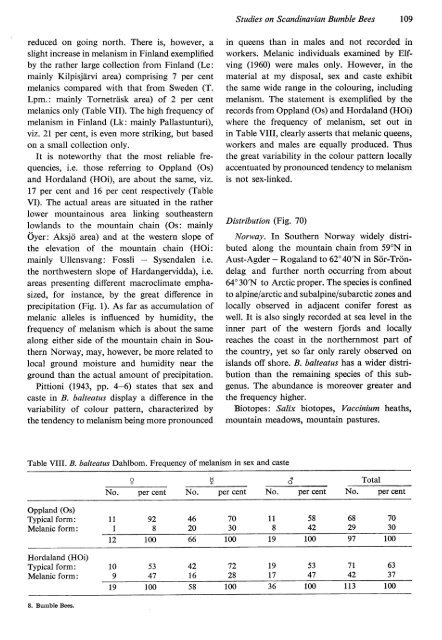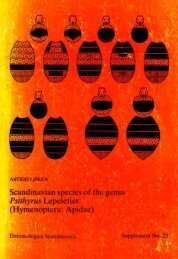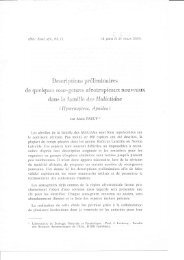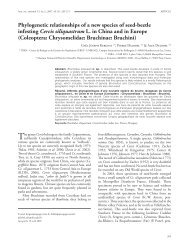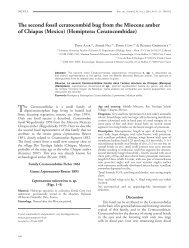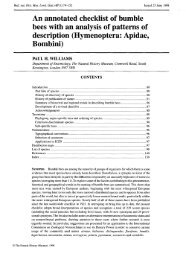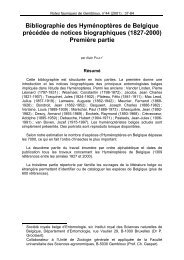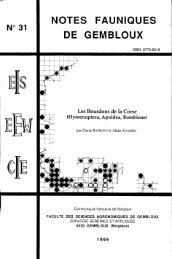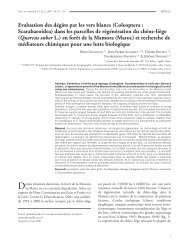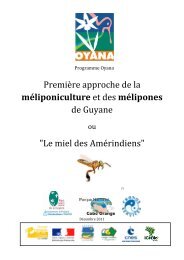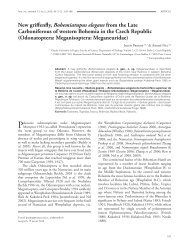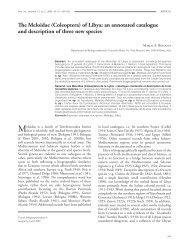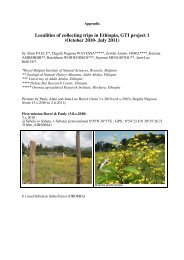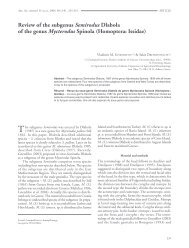Bumble Bees
Bumble Bees
Bumble Bees
Create successful ePaper yourself
Turn your PDF publications into a flip-book with our unique Google optimized e-Paper software.
Studies on Scandinavian <strong>Bumble</strong> <strong>Bees</strong> 109reduced on going north. There is, however, aslight increase in melanism in Finland exemplifiedby the rather large collection from Finland (Le:mainly Kilpisjtirvi area) comprising 7 per centmelanics compared with that from Sweden (T.Lpm.: mainly Tornetriisk area) of 2 per centmelanics only (Table VII). The high frequency ofmelanism in Finland (Lk: mainly Pallastunturi),viz. 2l per cent, is even more striking, but basedon a small collection only.It is noteworthy that the most reliable frequencies,i.e. those referring to Oppland (Os)and Hordaland (HOi), are about the same, viz.17 per cent and 16 per cent respectively (TableVI). The actual areas are situated in the ratherlower mountainous area linking southeasternlowlands to the mountain chain (Os: mainlyOyer: Aksjo area) and at the western slope ofthe elevation of the mountain chain (HOi:mainly Ullensvang: Fossli Sysendalen i.e.the northwestern slope of Hardangervidda), i.e.areas presenting different macroclimate emphasized,for instance, by the great difference inprecipitation (Fig. 1). As far as accumulation ofmelanic alleles is influenced by humidity, thefrequency of melanism which is about the samealong either side of the mountain chain in SouthernNorway, mey, however, be more related tolocal ground moisture and humidity near theground than the actual amount of precipitation.Pittioni (1943, pp. 4-6) states that sex andcaste in B. balteatus display a difference in thevariability of colour pattern, charactefized bythe tendency to melanism being more pronouncedin queens than in males and not recorded inworkers. Melanic individuals examined by Elfving(1960) were males only. Flowever, in thematerial at my disposal, sex and caste exhibitthe same wide range in the colouring, includingmelanism. The statement is exemplified by therecords from Oppland (Os) and Hordaland (HOi)where the frequency of melanisffi, set out inin Table VIII, clearly asserts that melanic queens,workers and males are equally produced. Thusthe great vaiabilityin the colour pattern locallyaccentuated by pronounced tendency to melanismis not sex-linked.Distribution (Fig. 70)Norway. In Southern Norwaywidely distributedalong the mountain chain from 59"N inAust-Agder - Rogaland to 62" 40'N in Scir-Trondelagand further north occurring from about64" 30'N to Arctic proper. The species is confinedto alpinelarctic and subalpine/subarctic zones andlocally observed in adjacent conifer forest aswell. It is also singly recorded at sea level in theinner part of the western fiords and locallyreaches the coast in the northernmost part ofthe country, yet so far only rarely observed onislands off shore. B. balteatzs has a wider distributionthan the remaining species of this subgenus.The abundance is moreover greater andthe frequency higher.Biotopes: Salix biotopes, Vaccinium heaths,mountain meadows, mountain pastures.Table VIII. B. balteatus Dahlbom. Frequency of melanism in sex and casteNo. per cent No. per cent No. per centNo.Totalper centOppland (Os)Typical form:Melanic form:Hordaland (HOi)Typical form:Melanic form:11 92 46 70 11 58 68 70I 8 2 0 3 0 8 4 2 2 9 3 0l2 100 100 t9 100 10010 s3 42 72 19 53 71 639 4 7 1 6 2 8 1 7 4 7 4 2 3 7t9 100 58 100 100 113 1008. <strong>Bumble</strong> <strong>Bees</strong>.


